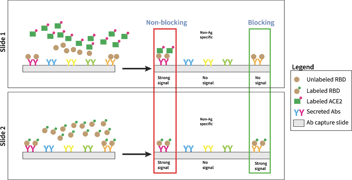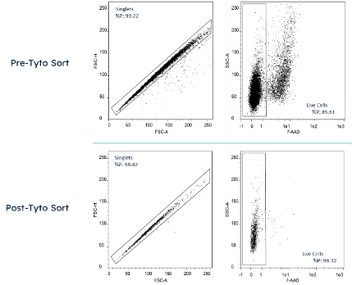Cell-based functional bioassays for antibodies targeting BCMA and B7-H3
In our latest webinar, we presented our workflow for validating antibodies from AbTheneum™ using cell-based bioassays. In my previous blog post, I made the case for testing antibodies for cell-based function earlier rather than after several in vitro assays. In this post, I will be sharing the antibody validation data presented during the Promega webinar for two AbTheneum™ campaigns.
Bioassay workflow
The Promega thaw-and-use bioassay kits are convenient and fast. Depending on the target cell line used, the assays can be run in just over 24 hours. If the target cells are cultured, then the assay can be run 1 or 2 weeks after thawing the cells and they are well established in culture.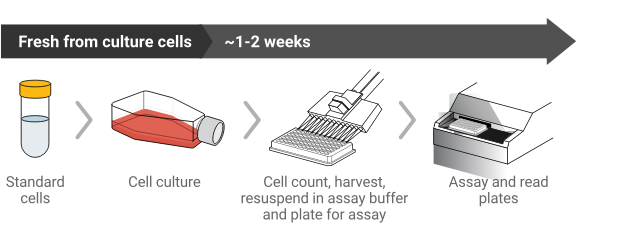
If your target cell line is in a thaw-and-use format, then the assay can be run in 1-2 days. Often these thaw-and-use cells are adherent and require plating about 18 hours before running the assay. The assay times vary, depending on the bioassay being run.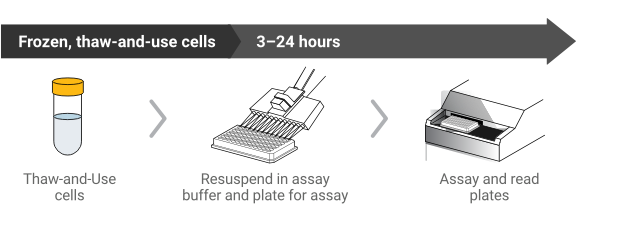
In our lab, since we test cell-based function before other in vitro assays, we don't know which antibodies are likely to perform well. For this reason, we can run a "quick screen" with all reconstructed antibodies. The quick screen has no duplicates, and fewer concentration points, but the data shows which antibodies have no response which can be excluded from the full screen.
It is also a good idea to identify 2 cell lines to serve as target cells for both quick screens and full screens, because expression levels can vary.
BCMA
B-cell Maturation Antigen (BCMA) is a member of the TNF-receptor superfamily. It is expressed in mature B lymphocytes, but not in T-cells or monocytes. BCMA is a very selective antigen to be targeted in multiple myeloma. There are several treatment modalities in various stages including CAR-T (bluebird bio, Legend, Juno), ADC (GSK, Amgen), Bispecifics (Regeneron, Amgen, J&J, Abbvie), and others (Unum, Poseida).
An AbTheneum™ campaign against BCMA yielded 317 antibody sequences. The total number of unique antibody sequences was 180, which clustered into 79 sequence families. 15 antibodies were selected from the output for reconstruction.
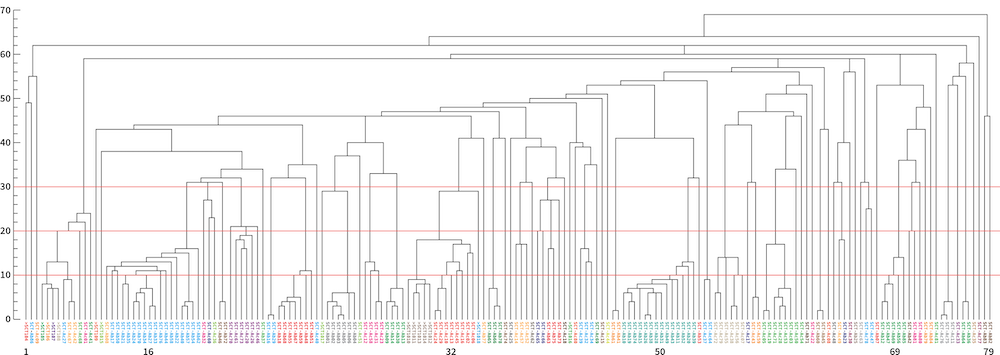
Using the quick screen workflow on the Promega reporter bioassay, 11 of the 15 (73%) had ADCC activity. This data was extensively covered in our CHI webinar, now available to watch on demand. For BCMA, we used U266 and MM.1S for target cell lines. For most antibodies, the MM.1S data was better than the U266, but both target cell lines had good expression of BCMA and the ranking of antibodies was similar. Also, the AbTheneum™ antibodies performed similarly or better than a control antibody from Biogen that has been tested in the clinic.
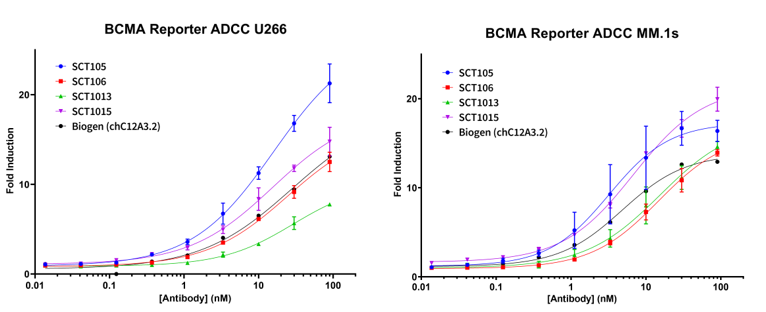
Coordinating closely with Promega, we selected 4 of the best anti-BCMA antibodies along with two positive controls (J22.9-xi and anti-CD38) were run in Promega's new PBMC ADCC assay, currently in development. This assay is different from the reporter bioassay (above). There are some researchers who have raised concerns that the reporter bioassay does not definitively demonstrate that the antibody induces cell killing. The Reporter bioassays use an engineered effector cell, that gives a luminescent signal when complexed with an antibody on the FCγ receptor, rather than killing the target cells. This PBMC ADCC assay is more similar to the traditional ADCC assay, including using human PBMC vials that are assayed for the kits.
The data from the PBMC ADCC assay confirmed that the 4 AbTheneum™ antibodies perform well and induce cell killing. The assay had 2 runs with duplicates for each antibody. Each run used a different vial of PBMCs. It is a good idea to do at least 2 runs for this type of assay because PBMC samples can vary in the natural killer (NK) cell population.
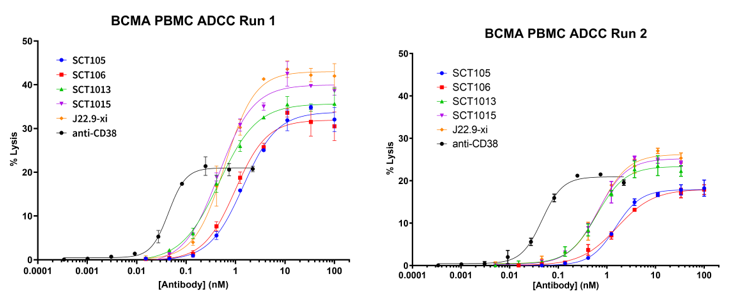
We are pleased to show this data on the anti-BCMA mAbs, as we think it is a powerful demonstration of going from AbTheneum™ output to functional leads. The data also shows a correlation of the Reporter bioassays with the new PBMC-based bioassay from Promega, which can give a depth of data in your antibody development.
B7-H3
B7-H3 (CD276) is an immune checkpoint molecule from the B7 family. This molecule is overexpressed in many cancers, which has made it a popular drug target in the oncology space with players such as MacroGenics (MGA271) and Memorial Sloan Kettering Cancer Center (8H9).
An AbTheneum™ campaign against B7-H3 yielded 362 antibody sequences. 12 diverse antibodies were selected from the output for reconstruction.
The best 5 antibodies from the quick screen were run using the Promega reporter bioassay, along with a positive control from clinical trials, labeled C731. For B7-H3, we used A-498 and SK-MES-1 for target cell lines. We did observe some differences between the two cell lines, especially for the 1001 antibody.
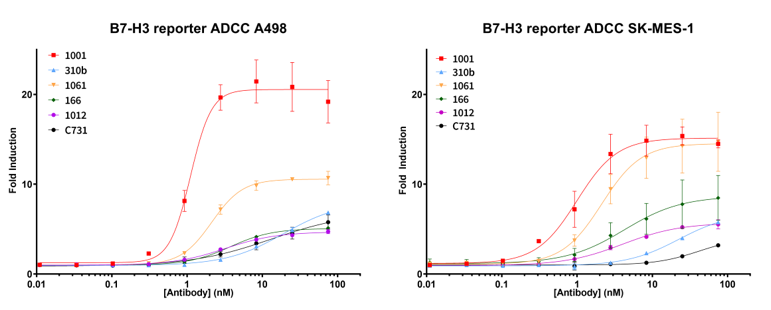
Like with BCMA, we also ran antibodies in the PBMC ADCC assay, still in development. 3 antibodies from the reporter assay were chosen (1001, 1061, and 1012), two of them were humanized (h1001 and h1061). The humanization of these antibodies will be the subject of a future blog post. These 5 antibodies were run with a positive control, Cetuximab (Brand name Erbitux), an anti EGFR antibody drug. The EGFR is on the target cells in the assay, so Cetuximab in this case is an assay control sample.
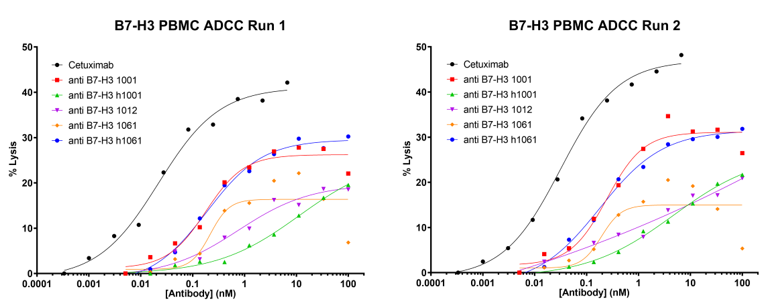
The data from both the reporter and PBMC bioassays shows that the antibodies from AbTheneum™ are good quality. We have also demonstrated that early functional tests can help narrow the focus during antibody development to the most promising leads.
Recommendations for bioassays
We have run several different bioassays on antibodies from AbTheneum™, and we have some recommendations that would be helpful for other users:
- Run functional tests early: To get to functional leads quicker, we fast-forward straight to the end. Since AbTheneum™ delivers the full-length sequence, SCT uses the sequence to select the most diverse candidates upfront and then we put them directly into a functional bioassay.
- Do a quick screen: If you have a lot of antibodies and not a lot of assay data on them, down-select your set by doing a quick screen by function. Then you can focus your time and efforts on the antibodies that are the most valuable.
- Use 2+ target cell lines: Expression levels can vary a lot by cell line. To ensure you are building a reliable data set, use at least 2 target cell lines.
Overall, the bioassays are easy to use, and they are a good way to speed ahead to functional leads.

